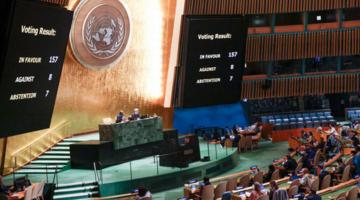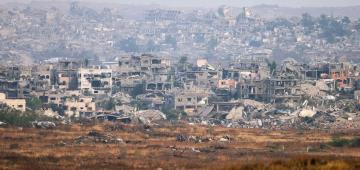MAGE: Oct. 17, 2024: Civil defense teams and residents launch a search and rescue operation around the house of the Mukayyed family that was destroyed after Israel attacked the Gaza Strip (Source: Ashraf Amra/Anadolu)
A recent report prepared by Garb Yaakov, a Professor at Ben-Gurion University of the Negev in Israel, and published on The President & Fellows of Harvard College Dataverse website, has substantiated that the actual number of individuals killed by Israel in the Gaza Strip exceeds 300,000. The report suggests that the real number significantly surpasses the officially reported death toll, as victims who are buried under debris or dismembered are not included in mainstream reports.
Originally published in 21st Century Wire.
Yaakov Garb’s report [Garb, Yaakov, 2025, “The Israeli/American/GHF ‘aid distribution’ compounds in Gaza: Dataset and initial analysis of location, context, and internal structure”, https://doi.org/10.7910/DVN/QB75LB. Harvard Dataverse] has analysed the Israeli military’s own data and combined these with careful spatial mapping to reveal a “demographic horror story”. The report presents maps, locational data, and an initial concise analysis of the Israeli/American/GHF aid distribution facilities that were swiftly constructed and commenced operations in Gaza in May 2025. The overall geographic relationship of these facilities to the Gazan population and the infrastructures of Israeli military control over Gaza, along with their consistent internal design, indicates that their architecture is primarily tailored to align with Israeli military strategies and tactics, rather than being focused on a comprehensive humanitarian relief effort. The reports unequivocally demonstrate that the Gaza Humanitarian Foundation (GHF) compounds are strategically placed and built to be inaccessible to most, particularly to the one million residents of Gaza City, cut off by the Netzarim corridor. The current system fails to support the 1.85 million accounted for, let alone the 377,000 missing Palestinians in the Gaza Strip.
See: Garb, Yaakov, 2025, The Israeli/American/GHF aid distribution compounds in Gaza: Dataset and initial analysis of location, context, and internal structure (Source: Dataverse Harvard). The report concludes that “If an attacker (occupier) cannot adequately and neutrally feed a starving population in the wake of a disaster it is ongoingly creating, it is obligated to allow other humanitarian agencies to do so”. The outlet Medium does a fantastic job at breaking down what they have described as “grim arithmetic”…
The grim arithmetic: IDF data reveals 377,000 Palestinians unaccounted for
A recent report by Yaakov Garb of the Harvard Dataverse presents an atrocious, data-driven analysis of the new “aid distribution” compounds in Gaza1. Through meticulous spatial mapping, the report argues these facilities are not the humanitarian breakthrough they are claimed to be, but rather instruments of military strategy that defy international law.
While the legal violations are stark, a deeper look at the population figures cited within the report reveals a demographic horror story that has, until now, remained buried in the rubble: a population gap of nearly 400,000 people.
These two themes — the perversion of aid and the decimation of a population — are inextricably linked. They paint a picture not of a relief effort, but of a strategy that advances military objectives while creating a façade of humanitarianism to placate international observers3.
Part I: The Architecture of control, not compassion
IHL is not a set of polite suggestions; it is a body of binding obligations. As the occupying power, Israel has a duty under the 4th Geneva Convention to ensure and facilitate the provision of food and medical supplies to the civilian population. The system described in the Garb report makes a mockery of this duty.
Instead of facilitating the work of experienced, neutral humanitarian agencies, Israel has crippled them in favor of a securitized alternative. This new model presents several grave violations:
- A Rejection of Neutrality: Aid is being distributed from fortified compounds operated by private American security companies staffed with combat veterans, all under the protection of the Israeli army. This arrangement obliterates the core humanitarian principles of neutrality and independence, which are essential for ensuring aid is not used as a tool of war.
- The Endangerment of Civilians: The compounds are located within Israeli-declared “buffer zones” where civilian entry is formally barred and liable to attack. In a cruel paradox, Palestinians must risk their lives by entering a prohibited military zone to receive life-sustaining aid.
- A Blueprint for Violence: The internal design of these compounds is a masterclass in military crowd control, not civilian care. The report identifies a “fatal funnel” layout — a single entry and exit path with no cover, designed to maximise surveillance and control for armed guards. This layout, devoid of shade, water, or toilets, is documented to induce panic and create the very chaos that can be used to justify a violent response. This is not a system designed to help; it is a system designed to control, and if necessary, to harm.
This entire setup is described as the “inverse of well-accepted and tested principles of food distribution”. It is a legal and moral charade, using the spectre of aid to advance tactical goals.
Part II: The unspoken number: Gaza’s Missing 377,000
As damning as the legal analysis is, the population data contained within the report’s maps points to a far greater catastrophe. Before the conflict, the population of the Gaza Strip was approximately 2.227 million. The Garb report includes maps displaying IDF estimates for the populations remaining in what are considered the three primary enclaves.
The numbers are as follows:
- Gaza City: 1 million
- Mawasi: 0.5 million
- Central: 0.35 million
The total of these official estimates is 1.85 million people.
Simple arithmetic reveals a horrifying gap: 2.227 million minus 1.85 million leaves 377,000 people unaccounted for.
This number is more than six times the casualty figures commonly discussed in media reports. While some of these individuals may be displaced in the rubble-strewn landscapes outside the main enclaves, the sheer scale of this discrepancy, derived from the occupying power’s own population assessments, is staggering. It suggests a demographic catastrophe — whether from direct casualties, starvation, or disease — far exceeding what the world has been led to believe.
The aid compounds and the missing population are two sides of the same coin. The compounds are positioned and designed in a way that makes them inaccessible to the majority of the population, particularly the one million people in Gaza City who are cut off by the Netzarim corridor. The system is not designed to feed the 1.85 million who can be counted, let alone address the fate of the 377,000 who cannot.
The international community must look beyond the veneer of these aid compounds and confront the grim reality they represent. We must condemn a system that uses the promise of food to force a desperate population through militarised chokepoints. But more urgently, we must demand an answer to the most pressing question this data raises:
Where are the missing 377000 Palestinians?


















